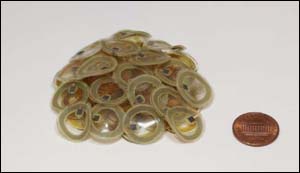Battery-free wireless sensors collect temperature and pressure of bedridden patients
10. 4. 2018 | Medical Xpress | www.medicalxpress.com
A team of researchers from the U.S., China and Korea has developed a small, skin-like sensor that can be attached to a human patient to collect temperature and pressure information and wirelessly send it to healthcare workers. In their paper published in the journal Science Translational Medicine, the group describes the sensor, how it works and how well it did when compared with conventional sensors.
Taking the temperature of patients in a hospital setting is a quick way to test for the onset of an infection. Also, testing for pressure in patients bedridden for long periods of time can alert caretakers to the need to take action to prevent bedsores. While everyone knows how to take temperature, the process for testing for pressure is less well known—typically, it involves insertion of an uncomfortable anal probe. In this new effort, the researchers have developed a sensor that can provide constant temperature and pressure readings from multiple sites—all without the need for any batteries.

The sensor the team developed is meant to be used as part of a set—several of the sensors are applied to the skin of the patient at various sites (on average, 65 of them, depending on the size of the patient). Each collects information and sends data to an NFC transmitting coil under the patient's bed.
Read more at Medical Xpress
Image Credit: Seungyong Han a Sang Min Won
-jk-




